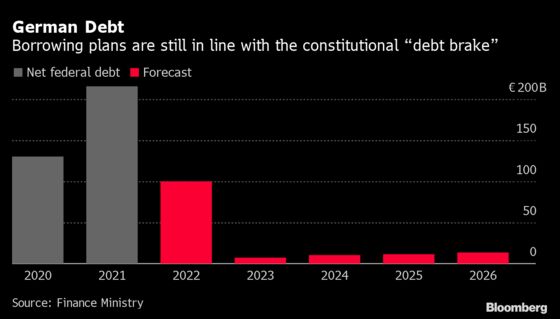Germany to Borrow at Least $220 Billion to Fund Historic Reset
Germany to Borrow Up to $220 Billion More for Defense, Climate
(Bloomberg) -- Germany plans additional borrowing of at least 200 billion euros ($220 billion) this year to finance a fund to modernize the military alongside already-planned debt for climate protection and other initiatives.
The latest borrowing binge marks the third consecutive year that Germany has breached constitutional limits and highlights how the new government is prepared to unleash massive spending to deal with seismic events like the pandemic and the war in Ukraine.
In the 2022 federal budget -- approved Wednesday by the cabinet -- the government is targeting as much as 99.7 billion euros in new borrowing, in line with previous planning, though the final figure is likely to be even higher when the impact of Russia’s invasion of Ukraine is taken into account. Another 100 billion euros will come on top for defense in a dedicated off-budget fund.
Both Chancellor Olaf Scholz and Finance Minister Christian Lindner have made it clear that an adjustment will be required to deal with the economic fallout from the war. That would be in addition to plans to spend billions of euros to tackle climate change and offset the lingering effects of the coronavirus pandemic on Europe’s biggest economy.
The current total for new borrowing in 2022 is already the second-highest since World War II, just short of last year’s record of 215 billion euros.
Lindner said the budget adjustment will be presented “as soon as possible” and will take into account extra spending to ease the burden on consumers from surging energy prices, money needed to help refugees and fund humanitarian aid abroad, as well as measures to bolster the economy.

“The government is doing everything in its power to stabilize the German economy,” Lindner said at a news conference in Berlin. He wouldn’t elaborate when asked if that might include a stimulus package similar to the one deployed to address the impact of the pandemic.
Scholz announced the surprise decision to allocate 100 billion euros to shore up Germany’s military capabilities in a speech to parliament last month. After years of restrained investment in security, Germany aims to meet and even exceed NATO’s target for military spending of 2% of economic output each year.
The defense fund and Lindner’s budget plans through 2026 also cleared cabinet on Wednesday. Next year, the government plans to restore the so-called “debt brake” and new borrowing is projected to shrink to 7.5 billion euros. Lindner called the mechanism “Germany’s fiscal reinsurance” and said it’s “the rule, not the exception.”
Germany’s move on defense spending was welcomed by the U.S. and European allies as a long-awaited U-turn in security policy. Berlin was seen as finally stepping up on the global stage after decades of restraint due to the country’s role in two world wars.
Scholz wants to make the fund legally watertight by writing it into Germany’s constitution, for which a two-thirds majority is needed in both chambers of parliament.
The opposition conservatives led by Christian Democratic Union Chairman Friedrich Merz have signaled their support. Lawmakers have said they expect the defense fund to be passed quickly in coming weeks, with the aim of tapping the first tranches of cash as early as April.
The 100 billion euros will be spent over the coming years and come on top of the federal government’s regular budget in which around 50 billion euros are slated for defense and military spending each year.
Marcus Faber, a defense expert from Lindner’s Free Democrats, told Bloomberg Tuesday that the government was planning to spend 15 billion euros on 50 new fighter jets.
Other outlays will likely include around 20 billion euros on ammunition and renewal of military equipment, more than 5 billion euros on new cargo helicopters and some 4 billion euros for the modernization and purchase of armored personnel carriers.
©2022 Bloomberg L.P.